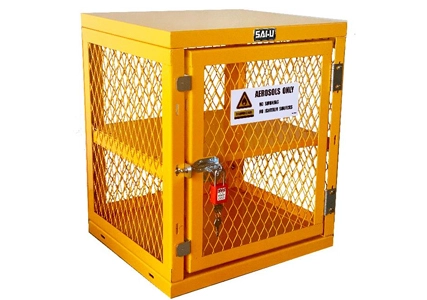English
Safety storage cabinets are essential for securely housing hazardous materials such as flammable liquids, corrosives, and other dangerous chemicals, acting as the first line of defense against fires, spills, and contamination. These cabinets provide a safe, EPA-compliant method for storing substances like pesticides, combustibles, and corrosives, protecting them from accidents that could occur if left in the open. Unlike basic storage units, professional-grade cabinets are built to withstand extreme conditions, including pressure, heat, and physical force, ensuring the safety of the chemicals stored inside. Regulatory bodies like the Occupational Safety and Health Administration (OSHA) and the National Fire Protection Association (NFPA) set strict guidelines for their use, emphasizing the importance of proper storage. With a variety of flammable storage cabinets available, selecting the right one requires careful consideration of several key factors to meet specific workplace needs.
The first step in choosing the appropriate safety storage cabinet is to assess your company's current and future storage requirements. Conducting a thorough inventory of all on-site chemicals, including their types and quantities, is crucial. This inventory should cover materials such as liquid gasoline fuels, aerosol paints, or corrosive acids to determine the specific cabinet types needed. Safety storage cabinets are categorized based on the materials they are designed to store, and it's vital to segregate chemicals according to their hazmat classifications, ensuring they are stored in cabinets made of compatible materials. OSHA regulations also limit the volume of materials that can be stored in a single cabinet. Cabinets are designed with distinct colors and exterior warning labels to indicate the type of hazardous material stored inside, and their shells and internal shelves must be capable of containing liquid spills. For added security, all cabinets should be lockable, with some models allowing the addition of a padlock for extra protection. Selecting a cabinet tailored to the specific material handling needs of your workplace is critical for safety and compliance.
Flammable liquid storage cabinets are designed with 18-gauge steel construction to provide optimal fire resistance and are typically yellow in color. Available in sizes ranging from 4 to 90 gallons, these cabinets come with options for manual or self-closing doors. To comply with OSHA and NFPA Code 30, they must protect their contents for at least 10 minutes during a fire, ensuring safety under hazardous conditions.
Paint and ink safety cabinets are ideal for storing combustible liquids and aerosol cans, available in red or yellow powder-coated steel. These cabinets come in various sizes and configurations, with or without self-closing doors, and feature adjustable shelves to maximize space and organize contents efficiently. In environments with moisture concerns, tower cabinets with legs are recommended to enhance ventilation and prevent corrosion.
Cabinets designed for acids and corrosives are built to resist chemical vapors and spills, typically constructed from durable steel or polyethylene and colored blue. They are available in sizes suitable for under-counter, benchtop, or lab workbench placements. For aggressive acids like sulfuric, nitric, or hydrochloric, polyethylene cabinets are recommended, as these acids should not be stored in steel cabinets. Additionally, nitric and sulfuric acids must never be stored in the same unit to prevent dangerous reactions.
Pesticide safety storage cabinets, typically green and made of heavy-duty steel, are designed to store toxic pesticides and insecticides. Equipped with corrosion-resistant polyethylene shelves, these cabinets are available with manual or self-closing doors, making them an excellent choice for agricultural businesses handling chemical poisons.
Drum storage cabinets, usually yellow to indicate flammable hazard classification, are designed to accommodate 30 or 50-gallon containers of combustible or hazardous materials. Available in horizontal or vertical configurations, with or without self-closing doors, these cabinets often include roller conveyors at the base to facilitate easier handling of heavy drums.
The choice of material for safety storage cabinets depends on the chemicals they will store, with stainless steel and polyethylene being the most common for professional-grade units due to their strength, durability, and longevity. Steel cabinets are unsuitable for storing aggressive acids like sulfuric, hydrochloric, or nitric, which require polyethylene cabinets. These polyethylene cabinets feature sealed internal containment sumps and vents for added safety, though they are not non-flammable. Many steel cabinets come with a corrosion-resistant powder coating, which provides an additional layer of protection against damage from chemical spills. This coating is a standard feature in high-quality steel safety cabinets, enhancing their ability to withstand corrosive substances.
Selecting the right cabinet size and configuration is essential for optimizing available floor space. Beyond standard floor models, cabinets are available in slimline, tower, stackable, under-counter, or wall-mount designs, most of which feature adjustable shelves for customized storage. Tower cabinets with adjustable legs are ideal for sites with uneven floors or moisture issues, offering 4-inch clearance to improve ventilation and reduce corrosion risks. These models are also easier to move with a forklift or pallet jack and can be placed over vents or wires. Cabinets with roller inserts are particularly useful for quick access to 55-gallon drums, enhancing workplace efficiency.
Ensuring compliance with local regulations is critical when selecting a safety storage cabinet. Some states, under the International Fire Code (IFC), mandate self-closing doors, while others impose restrictions on cabinet placement or the number of flammable storage cabinets allowed in one location. Independent certifications from organizations like Factory Mutual Global (FM) or Underwriters Laboratory (UL) provide assurance that a cabinet has passed rigorous safety tests. Additionally, cabinets must meet OSHA and NFPA standards to ensure they are suitable for storing hazardous materials safely and in compliance with regulatory requirements.
